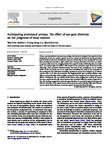Anticipating intentional actions: The effect of eye gaze direction on the judgment of head rotation
| dc.contributor.author | Hudson, Matthew | |
| dc.contributor.author | Liu, CH | |
| dc.contributor.author | Jellema, T | |
| dc.date.accessioned | 2021-08-20T17:15:51Z | |
| dc.date.available | 2021-08-20T17:15:51Z | |
| dc.date.issued | 2009-09 | |
| dc.identifier.issn | 0010-0277 | |
| dc.identifier.issn | 1873-7838 | |
| dc.identifier.uri | http://hdl.handle.net/10026.1/17638 | |
| dc.description.abstract |
Using a representational momentum paradigm, this study investigated the hypothesis that judgments of how far another agent's head has rotated are influenced by the perceived gaze direction of the head. Participants observed a video-clip of a face rotating 60 degrees towards them starting from the left or right profile view. The gaze direction of the face was either congruent with, ahead of, or lagging behind the angle of rotation. Following this, two static faces, at varying angles of rotation with respect to the end-point angle of the face in the video-clip, were presented simultaneously. The task of the participants was to decide which of the two heads was at an angle best resembling the angle of the end-point of the moving face. The critical test condition consisted of one test face oriented at 10 degrees before, and the other at 10 degrees after the end-point. The 'lagging behind' gaze condition elicited a significant underestimation of the rotation compared to the 'congruent' and 'ahead' gaze conditions. Participants did not exhibit similar biases when judging the rotation of several non-face control stimuli with visual features that mimicked different aspects of gaze direction. The findings suggest that when the gaze direction of a perceived agent is incongruent with the direction of the agent's head motion observers automatically utilise this discrepancy to adjust their inferences about the agent's intended heading direction. | |
| dc.format.extent | 423-434 | |
| dc.format.medium | Print-Electronic | |
| dc.language | en | |
| dc.language.iso | eng | |
| dc.publisher | Elsevier BV | |
| dc.subject | Goal directed actions | |
| dc.subject | Representational momentum | |
| dc.subject | Empathising | |
| dc.subject | Systemising | |
| dc.subject | Biological motion anticipation | |
| dc.title | Anticipating intentional actions: The effect of eye gaze direction on the judgment of head rotation | |
| dc.type | journal-article | |
| dc.type | Journal Article | |
| plymouth.author-url | https://www.webofscience.com/api/gateway?GWVersion=2&SrcApp=PARTNER_APP&SrcAuth=LinksAMR&KeyUT=WOS:000269639000006&DestLinkType=FullRecord&DestApp=ALL_WOS&UsrCustomerID=11bb513d99f797142bcfeffcc58ea008 | |
| plymouth.issue | 3 | |
| plymouth.volume | 112 | |
| plymouth.publication-status | Published | |
| plymouth.journal | Cognition | |
| dc.identifier.doi | 10.1016/j.cognition.2009.06.011 | |
| plymouth.organisational-group | /Plymouth | |
| plymouth.organisational-group | /Plymouth/Faculty of Health | |
| plymouth.organisational-group | /Plymouth/Faculty of Health/School of Psychology | |
| plymouth.organisational-group | /Plymouth/REF 2021 Researchers by UoA | |
| plymouth.organisational-group | /Plymouth/REF 2021 Researchers by UoA/UoA04 Psychology, Psychiatry and Neuroscience | |
| plymouth.organisational-group | /Plymouth/Users by role | |
| plymouth.organisational-group | /Plymouth/Users by role/Academics | |
| dc.publisher.place | Netherlands | |
| dcterms.dateAccepted | 2009-06-19 | |
| dc.identifier.eissn | 1873-7838 | |
| dc.rights.embargoperiod | Not known | |
| rioxxterms.versionofrecord | 10.1016/j.cognition.2009.06.011 | |
| rioxxterms.licenseref.uri | http://www.rioxx.net/licenses/all-rights-reserved | |
| rioxxterms.licenseref.startdate | 2009-09 | |
| rioxxterms.type | Journal Article/Review |


